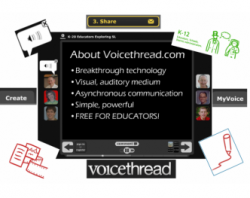Examples
Parts of a Plant - teaching a concept
Small Moment - writing example
The Secret School – book review
Mitch Miller Honor Roll Students - celebrating student successes
Schools Then and Now - report idea
How I Became a Super Hero - writing assignment
High Point High School - review of what has been learned
Help me write an ABC book - collaborative example
Lewis and Clark 4th Grade - report with student illustrations
Who we are - an example of International School Students introducing themselves. This example has many students commenting and sharing
Bell Work - an example by a teacher of a VoiceThread writing prompt.
From the VT Educator's Ning
3rd Grade US History & Constitution
Lesson Ideas Brainstorm
(1) uploaded photos of year 7 student posters about the water cycle and asked each student to describe the processess involved - I discovered that, although they had created their own posters, many were unable to articulate precipitation, condensation etc. correctly.
(2)Uploaded photos of a science experiment to separate a mixture of rice, sand, iron filings and salt. Students were asked to comment on each of the steps in the experiment. This was a little more successful, because slower students could follow the lead of quicker ones.
(3) Joint project on the structural, functional and behavioural adaptations of Australian and American animals. (work in progress).
I believe this tool has great potential - students should have their own avatars (logos) if they are going to be public documents and they often spend too long fiddling with these - creating their own identities. Younger students may need assistance in setting up microphones correctly, although they can also use text.
I am looking forward to spicing up my maths lessons with it too - the drawing tool will be helpful for students to identify specific angles and sides (for example, "the hypotenuse is here", "this is an acute angle" etc.)
Have fun and let me know if you have a great Voicethread lesson to share!
By Britt Gow http://education.ning.com/forum/topic/listForContributor?user=18kelzi14evnk.
We've been using Voicethread for a few months. My Kindergarten students wrote, illustrated and recorded list poems, first graders wrote, illustrated and recorded poems based on "The Important Book" by Margaret Wise Brown, my fourth graders uploaded their animations and my fifth graders created a Voicethread for Women's History Month. I love Voicethread! I am the account holder and all my students have created avatars and are listed as Identities on my account. You can link to our Voicethreads through our blog, ps233techteacher.edublogs.org
By Ellen http://education.ning.com/forum/topic/listForContributor?user=ellenquilt


Comments (0)
You don't have permission to comment on this page.